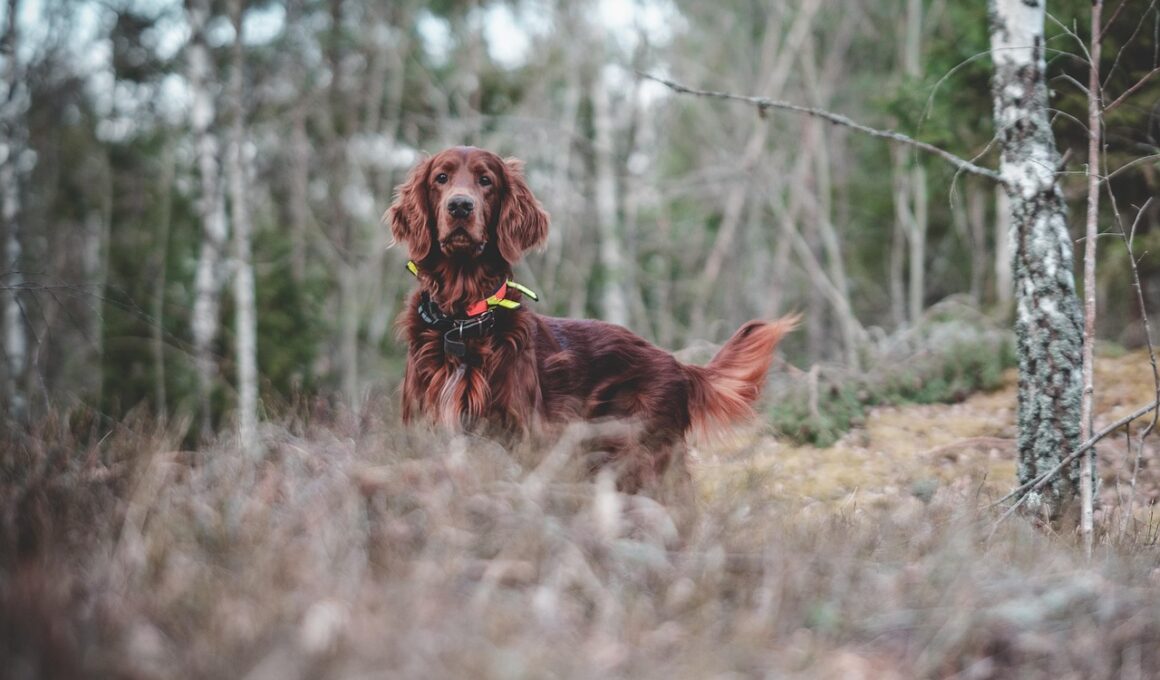Importance of Journaling in Dog Sports
Effective journaling is essential in dog sports. Recording each training session allows athletes to identify successful strategies and analyze performance trends. Keeping a structured journal helps in monitoring a dog’s progress over time. You’ll be able to pinpoint strengths and weaknesses, ensuring a more tailored training approach. Moreover, this practice promotes accountability. When you write down goals and relative outcomes, you are more likely to commit to these objectives. It becomes easier to track if those goals were met and what changes may need to be implemented in future sessions. Regularly analyzing these records can indicate when certain techniques yield the best results, leading to more successful training outcomes. A training log should not only track successes but also note any setbacks and how they were addressed. This living document fosters long-term growth for both the handler and the dog. Consequently, prioritizing the maintenance of a comprehensive training journal is key to success in various dog sports. The benefits are profound, impacting the overall performance in competitions and daily practices alike.
Creating a Systematic Format for Journaling
To maximize the benefits of your dog sports journal, establish a systematic format for recording your sessions. Choose a structure that makes it easy to be consistent. Regular entries can enhance focused training efforts and facilitate comparison over time. Consider including sections such as date, duration, activities undertaken, and specific observations. This allows for quick references in future training sessions. By incorporating success indicators such as behavior scores and obstacle completions, you can establish a deeper understanding of your training effectiveness. Also, it’s helpful to record your dog’s mood during various practices. This will inform you about their mental state, which is crucial for performance. Include an area for future training goals that you’d like to focus on as well. Revisiting these goals can help motivate both you and your dog. Regularly update your journal after every session to keep it accurate. This practice not only holds you accountable but also allows you to celebrate progress. A systematic approach can make a significant difference in your dog’s training journey.
Utilizing Technology for Tracking Sessions
In today’s digital age, leveraging technology can greatly enhance your dog sports journaling experience. Numerous applications are available that can assist in tracking performance metrics. Such applications help organize data seamlessly and allow for easy updates, making it simpler to monitor ongoing training progress. You can even utilize calendar reminders to log training sessions, receive alerts, and ensure regular updates. Video recording your training gives a visual representation of your dog’s performance. Reviewing these clips can provide insight into behaviors and techniques needing improvement. By combining video proof with written notes, you enhance your analytical capabilities dramatically, leading to more informed adjustments to training methods. Consider using spreadsheets to create graphs of your dog’s progress over time, adding a visual dimension to your records. Moreover, social media communities can offer support and feedback on your training logs and sessions. You can even create shared logs for group training sessions, thus promoting accountability among team members. This combined approach can streamline the journaling process while ensuring precise tracking.
Incorporating Feedback into Journaling
Feedback plays a crucial role in the journaling process. Incorporating input from trainers, other handlers, or online communities into your journal enhances its effectiveness. Record any suggestions or critiques received during training sessions. This practice allows you to apply constructive criticism effectively for improved results. Create a designated section in your journal solely to document feedback and the subsequent adjustments made. Regularly revisiting these notes ensures you remain aware of past suggestions, fostering continuous improvement. Additionally, seeking out peer feedback can illuminate areas you might overlook, providing you with alternative perspectives. Encouraging honest conversations with fellow trainers fosters a supportive community focused on shared goals. This communal approach not only enriches your knowledge but motivates continued growth. As you incorporate feedback, keep track of how these changes influence your dog’s training outcomes. Dialing in on what works can make a significant difference in performance. A well-documented journal that includes various perspectives can become your best resource. Ultimately, feedback transforms your training from good to great, empowering your dog’s athletic journey.
Setting Specific Goals for Each Session
One best practice in dog sports journaling is to define specific goals for each training session. Goals can vary based on the dog’s skill level, age, and overall training needs. Setting these goals makes tracking success much easier. It focuses both you and your dog during each exercise, ensuring that there are clear expectations. Be sure your goals are measurable, attainable, relevant, and timely, often recognized by the acronym SMART. For instance, instead of vaguely stating ‘improve agility,’ write, ‘Finish a 12-obstacle agility course under three minutes.’ This type of clarity allows for precise evaluations of progress. Regularly revisit and revise goals as your dog develops new skills. This incremental approach ensures that you’re always working toward something achievable. Celebrate when objectives are successfully reached to encourage motivation. Document any adjustments made to objectives based on the dog’s performance to foster development. A focused approach yields stronger training outcomes, giving you both a sense of accomplishment that can be motivating moving forward.
Documenting Health and Wellness
Keeping detailed records of your dog’s health and wellness is vital in dog sports training. A well-rounded journal doesn’t just track performance; it also notes any health routines or issues. Record vaccinations, vet visits, and changes in dietary habits that might affect performance. Being proactive about a dog’s health can prevent interruptions in training and help recognize any patterns related to performance dips. Additionally, it is essential to log any signs of fatigue or discomfort observed during training sessions. Monitoring these factors can lead to timely interventions that positively affect your dog’s athletic journey. Ensure you have regular veterinary check-ups documented, as this can serve as a reference point for identifying any potential concerns. Regular health assessments should be part of your journaling practice, allowing you to build a comprehensive profile of your dog’s well-being. In doing so, you create a holistic understanding of how health impacts performance. This approach not only enhances performance but also fosters a stronger relationship based on mutual understanding.
Reflecting on Training Progress
Reviewing your dog sports journal regularly is one of the best practices you can implement. Take time to reflect on previous sessions, assessing the various elements recorded. Recognizing patterns or trends within the journal can provide a comprehensive view of progress over time. This process allows you to gauge the effectiveness of training strategies and see what is truly working. Moreover, this retrospective analysis can reveal areas needing further attention or adjustment. Ask yourself questions as you review: What went well? What didn’t work? Adjusting your strategies based on these reflections can increase training effectiveness significantly. Share insights from your reflections with coaches or other handlers to gain further perspectives. Additionally, consider setting a dedicated day each month to go through your journal thoroughly and make any necessary updates or alterations. Creating a routine for this practice will ensure you remain engaged with your dog’s training and modifications. Continuous refinement of strategies based on reflective teaching can lead to optimal performance in competitions, fostering a strong bond between you and your canine athlete.
Staying Consistent with Journaling
The final key practice in successful dog sports journaling is consistency. Maintaining a regular schedule for entries ensures you capture each training session accurately. Daily or weekly journaling, depending on your training frequency, will keep your records organized. Find a medium that works best for you, whether it’s a physical notebook, an app, or online document. Make it part of your routine, perhaps at the end of each training session. The more consistent you are, the more valuable your entries become. Over time, you’ll build a rich resource of information that can significantly aid in training decisions. Schedule specific times to review your journal entries and adapt training plans accordingly. This proactive approach not only enhances your effectiveness as a handler but also ensures your dog’s improvement remains a priority. Emphasize that journaling is not just administrative work; it is an integral part of the training experience. Finally, make your journal a place of positivity where progress is celebrated. This mindset shift can make both you and your dog more excited about training, positively impacting your sport result.


